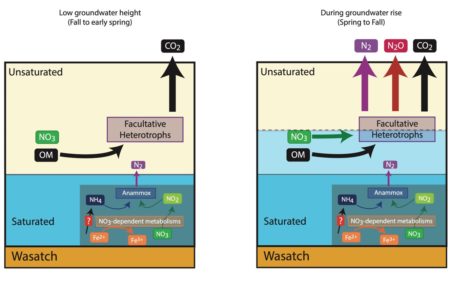
Schematic of the biogeochemical pathways cycling nitrogen at the capillary fringe of the Rifle floodplain, Colorado.
Alluvial sediments subject to the seasonal rise and fall of groundwater are regions of outsized biogeochemical activity relative to their spatial extent in many floodplain environments. This study documents significant changes in the nitrogen cycle under fluctuating hydrological conditions.
This manuscript significantly improves our understanding of the global nitrogen cycling by using natural abundance stable isotopes to document pathways and mechanisms leading to the accumulation and dissipation of nitrate under aerobic and anaerobic conditions.
Summary
In the current study, researchers characterize the nitrogen biogeochemistry of the subsurface at the Rifle Field Site, Colorado, as snowmelt driven fluctuations in water table depth change the saturation profile of the vadose zone sediments and hence their redox status. Depth-resolved water samples were collected over the course of a year with analysis of porewater nitrogen concentrations, nitrous oxide and nitrogen gas, and the natural abundance stable isotopes of nitrate (15NNO3 and (18ONO3) used to determine the role that abiotic and biological mechanisms play in the fate of nitrate. The study concludes that biological nitrogen cycling in Rifle sediments was predominantly attributable to temporally uncoupled nitrification-denitrification reactions. These reactions occur sequentially as aerobic conditions, favoring nitrification and the accumulation of nitrate, give way to anaerobic conditions, which favor denitrification rather than anaerobic ammonium oxidation, as the water table rises.
Citation
Bouskill, N. J., M. E. Conrad, M. Bill, E. L. Brodie, Y. Cheng, C. Hobson, M. Forbes, K. L. Casciotti, and K. H. Williams (2019), Evidence for Microbial Mediated NO3− Cycling Within Floodplain Sediments During Groundwater Fluctuations, Frontiers in Earth Science, 7(189), DOI: 10.3389/feart.2019.00189.
